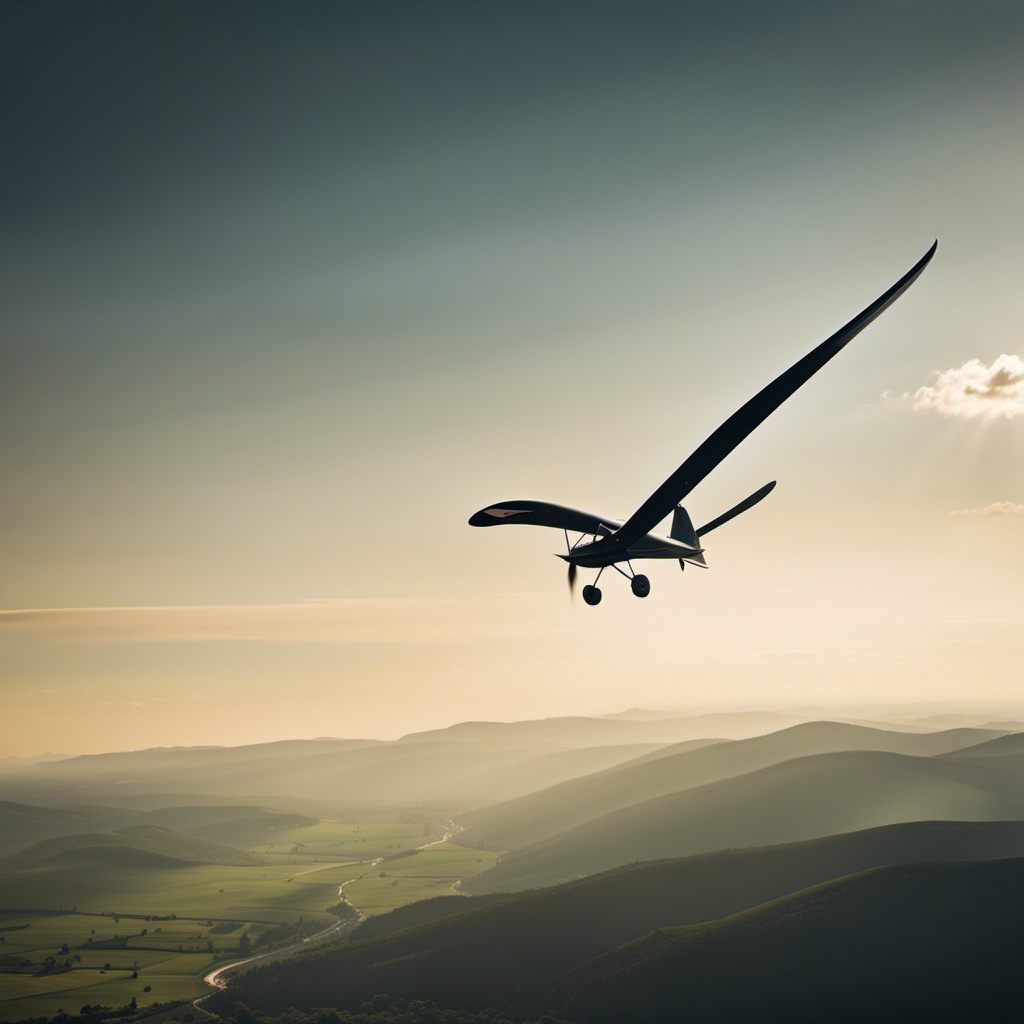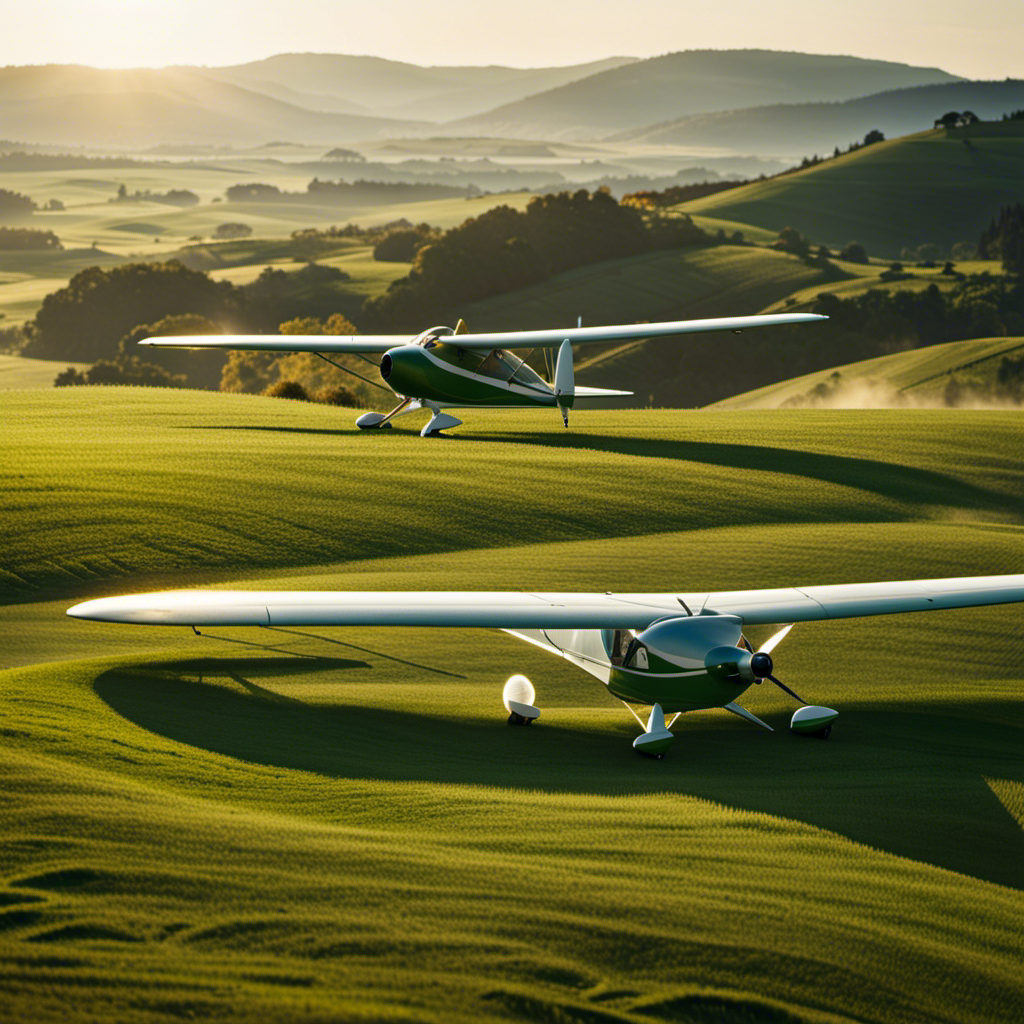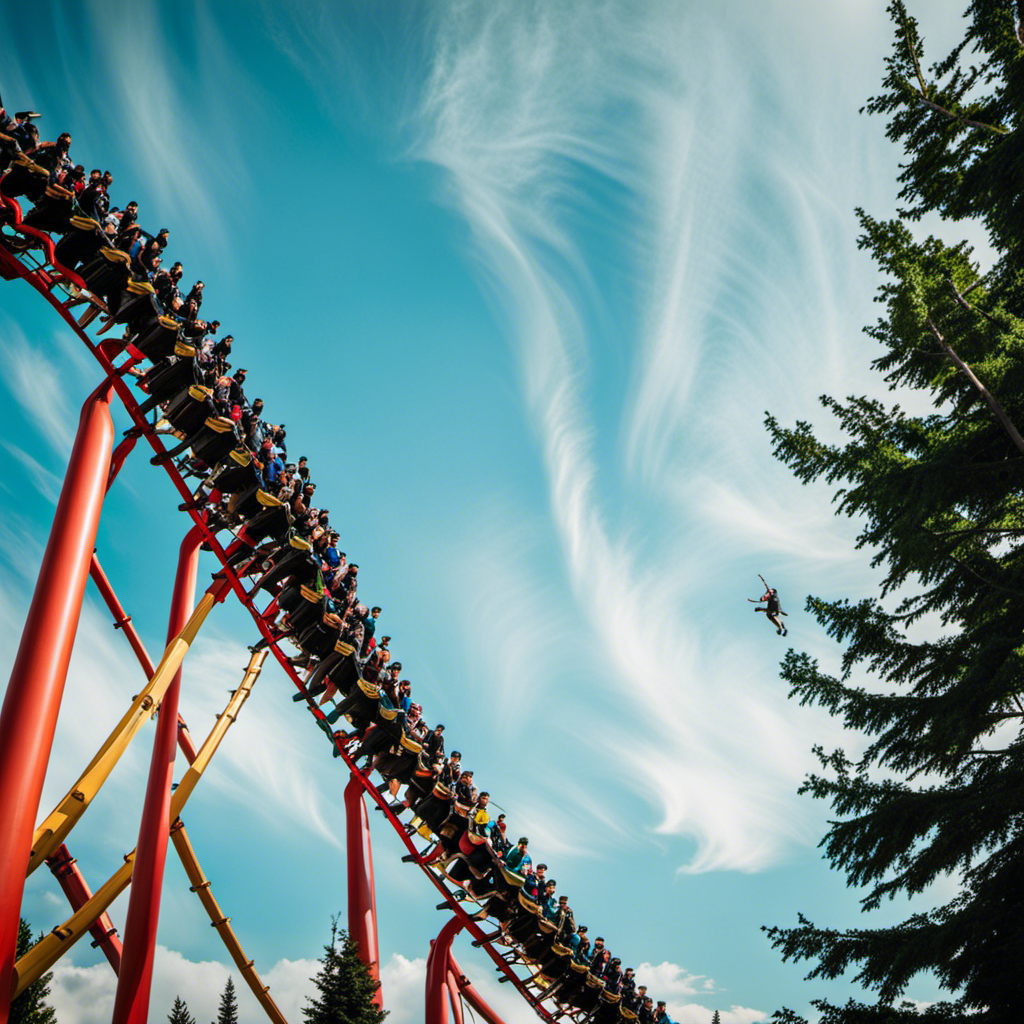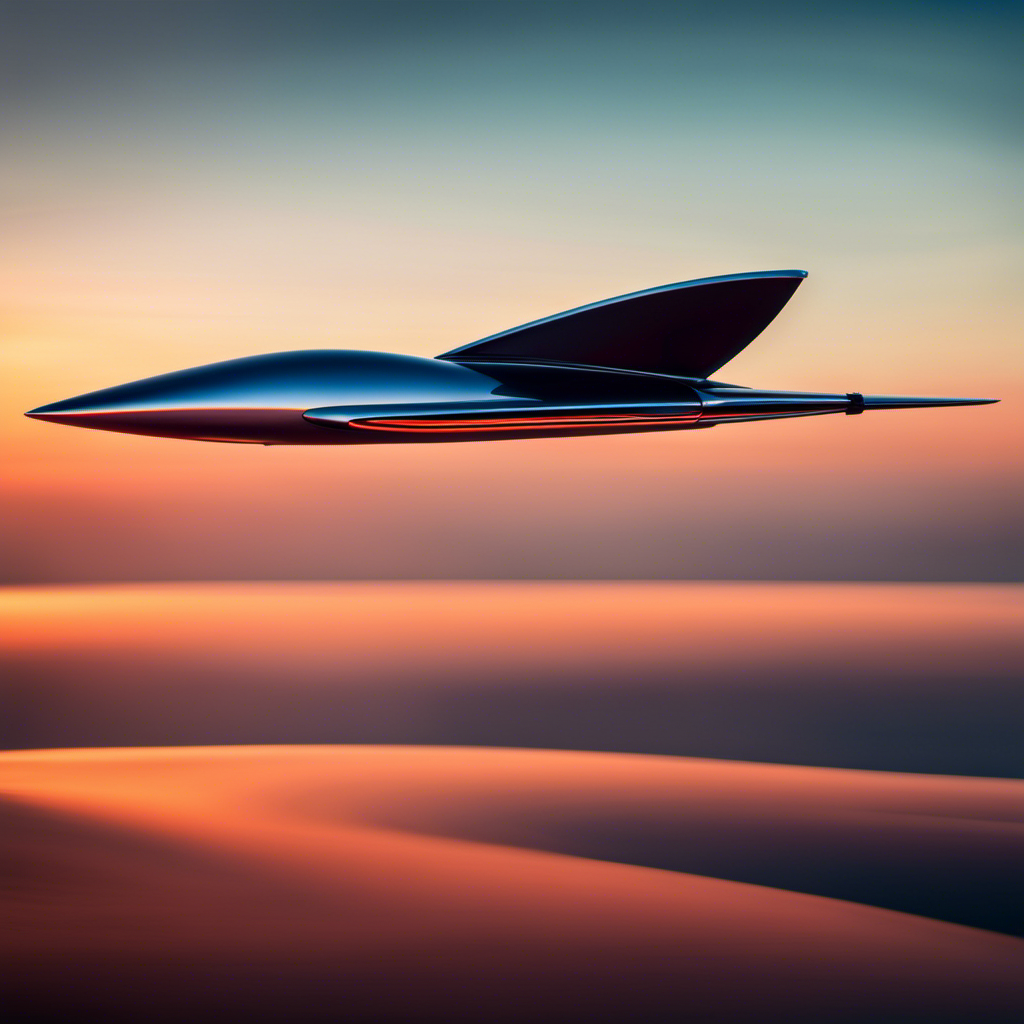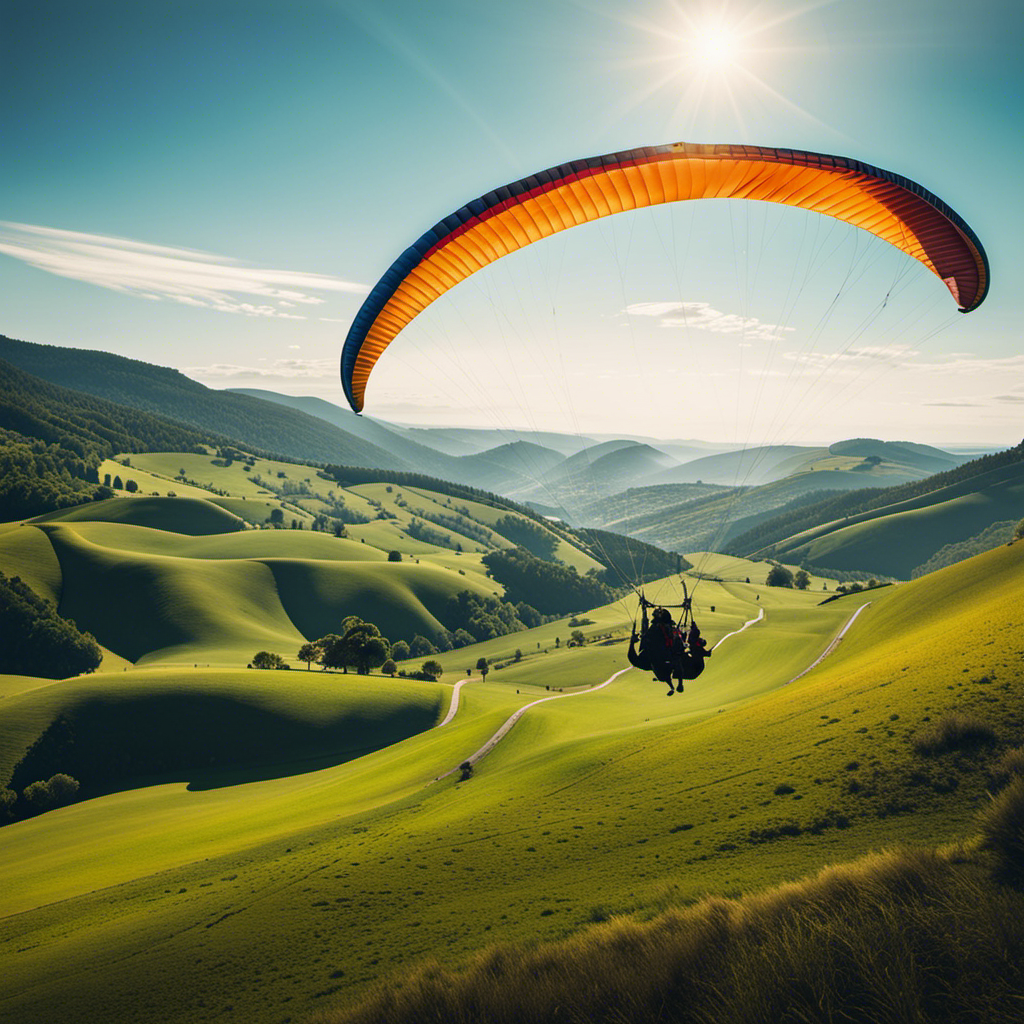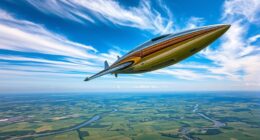I am always in awe of the engineering marvels that gliders represent as a enthusiast.
Did you know that gliders can stay aloft for hours without any engine power?
In this article, we will explore the fascinating history, principles of flight, design and construction, launching and flying techniques, as well as the advantages and popular destinations of glider aircrafts.
Join me on this journey through the skies as we delve into the world of these incredible flying machines.
Key Takeaways
- Gliding destinations such as the Alps, Great Plains, and New Zealand offer popular locations for glider enthusiasts.
- Notable glider records include the longest flight, altitude record, fastest speed, duration record, and largest gathering of gliders.
- Advancements in technology, including lightweight materials, aerodynamic optimization, and avionics systems, are shaping the future of glider aircraft.
- Gliders have potential applications in scientific research, environmental monitoring, tourism, transportation, surveillance, communication, and humanitarian aid.
History of Glider Aircrafts
The history of glider aircrafts can be traced back to the late 19th century. It all began with the pioneering work of Otto Lilienthal, who is often considered the father of gliding.
Lilienthal’s designs and experiments laid the foundation for modern glider technology. He meticulously studied the principles of aerodynamics and developed various wing designs to achieve lift and stability. His gliders, equipped with movable control surfaces, allowed him to maneuver in the air and control his flight path.
The success of Lilienthal’s gliders inspired many aviation enthusiasts and engineers to further explore the possibilities of glider flight. This marked the beginning of a new era in aviation, where glider aircrafts played a crucial role in understanding the principles of flight and paved the way for powered flight.
Understanding the history of gliders is essential to grasp the principles of flight for these engineering marvels of the sky.
Principles of Flight for Gliders
Flying gliders involves understanding the principles of flight and how to manipulate the controls for efficient soaring.
To achieve lift, gliders utilize the same fundamental principles as powered aircraft: Bernoulli’s principle and Newton’s third law of motion. The curved shape of the wings creates a pressure difference, with lower pressure on the top surface and higher pressure on the bottom. This creates lift, allowing the glider to rise.
The pilot controls the glider’s flight by manipulating the ailerons, elevators, and rudder. Ailerons control the roll, elevators control the pitch, and the rudder controls the yaw. By skillfully adjusting these controls, the pilot can maintain altitude, change direction, and even perform aerobatic maneuvers.
Understanding these principles and mastering the controls is essential for safe and efficient glider flying.
Now, let’s delve into the fascinating world of glider design and construction.
Design and Construction of Gliders
Designing and constructing gliders involves a combination of aerodynamic principles, materials science, and precise craftsmanship.
The aerodynamic design is crucial for achieving efficient lift and minimizing drag. The wings are designed with a specific shape, called an airfoil, which generates lift as air flows over it.
The materials used in constructing gliders are lightweight yet strong, such as carbon fiber composites or fiberglass. These materials ensure the glider is strong enough to withstand the stress of flight while remaining light for maximum performance.
Craftsmanship is also vital, as the glider must be built with precision to ensure smooth airflow and proper weight distribution.
With the glider’s construction complete, the next step is to understand the various launching techniques that allow gliders to take to the skies effortlessly.
Launching Techniques for Gliders
To launch a glider, you’ll need to master different techniques that allow for a smooth takeoff and ascent into the air.
One of the most common methods is a tow launch, where a powered aircraft tows the glider into the air using a tow line. This requires precise coordination between the pilot of the glider and the pilot of the tow aircraft.
Another technique is a winch launch, where a powerful winch at the end of the runway rapidly pulls the glider into the air. This method requires a strong and reliable winch, as well as skilled coordination between the winch operator and the glider pilot.
The launch phase is crucial for gaining altitude and energy, setting the stage for the subsequent flying techniques for gliders.
Flying Techniques for Gliders
As you gain altitude in your glider, you’ll quickly learn the importance of mastering different techniques for maintaining lift and maximizing your flight time.
One of the key techniques is called thermaling, which involves circling within a rising column of warm air called a thermal. By flying in a tight circle, you can gain altitude and stay aloft for longer periods.
Another technique is ridge soaring, where you fly close to a mountain ridge or cliff and take advantage of the updrafts created by the wind hitting the slope. This allows you to maintain lift without expending much energy.
Lastly, there’s wave soaring, which involves riding the waves of air created by strong winds passing over mountains. By understanding and utilizing these techniques, glider pilots can extend their flight time and explore the skies with efficiency and grace.
Now, let’s delve into the safety measures for glider pilots, ensuring a secure and enjoyable flying experience.
Safety Measures for Glider Pilots
Now let’s explore the safety measures that ensure glider pilots have a secure and enjoyable flying experience.
When it comes to glider aviation, safety is of paramount importance. Pilots are required to undergo thorough training and hold a valid glider pilot license. Before every flight, a meticulous pre-flight inspection is conducted to ensure the aircraft is in optimal condition. This includes checking the control surfaces, airframe, and safety restraints.
Additionally, gliders are equipped with emergency parachutes, which provide an added layer of safety in case of unforeseen circumstances. Furthermore, glider pilots are trained in emergency procedures such as aerotow releases, rope breaks, and forced landings.
By adhering to these safety measures, glider pilots can confidently take to the skies knowing that they are well-prepared for any situation.
Now, let’s delve into the advantages of glider aircrafts.
Advantages of Glider Aircrafts
You can experience the freedom of soaring through the air with glider aircraft, enjoying the tranquility and breathtaking views.
Gliders, also known as sailplanes, are unique flying machines that rely solely on the forces of nature to stay aloft. Unlike powered aircraft, they have no engines and are designed to glide through the air using the lift generated by the surrounding atmosphere. This makes gliders incredibly efficient and environmentally friendly.
With their sleek designs and lightweight structures, gliders are capable of staying airborne for hours at a time, covering vast distances with little energy consumption.
Not only do gliders offer a thrilling and serene flying experience, but they also provide an opportunity to explore some of the world’s most popular glider destinations. Pilots can take advantage of the unique weather conditions and stunning landscapes to enjoy the ultimate gliding adventure.
Popular Glider Destinations
For a breathtaking gliding experience, head to popular destinations known for their unique weather conditions and stunning landscapes.
These locations offer ideal conditions for gliders to soar through the sky.
In the Alps, the combination of high mountains and thermals created by the warm air rising from the valleys provides an exhilarating experience for glider pilots.
The Great Plains in the United States are renowned for their strong and consistent winds, which allow gliders to cover vast distances.
In New Zealand, the Southern Alps offer stunning views and challenging flying conditions, with strong winds and turbulent air currents.
Exploring these destinations will not only provide an unforgettable gliding experience but also a chance to witness some of the notable glider records and achievements accomplished by skilled pilots.
Notable Glider Records and Achievements
To truly appreciate the remarkable accomplishments in gliding, take a moment to delve into the world of notable glider records and achievements.
Here are some incredible feats that have been achieved in the world of gliding:
-
The longest glider flight ever recorded was achieved by Klaus Ohlmann in 2003, who flew a distance of 3,008.51 kilometers.
-
In 2012, Steve Fossett set the altitude record for gliders by reaching a staggering height of 15,460 meters.
-
The fastest speed ever reached by a glider was achieved by Alexander Müller in 2001, who reached a speed of 526.7 kilometers per hour.
-
In 1986, Hans-Werner Grosse set the duration record for gliders by staying airborne for 56 hours and 15 minutes.
-
The largest number of gliders ever assembled in one place was at the 2013 World Gliding Championships, where over 150 gliders were present.
These records and achievements highlight the incredible capabilities and potential of glider aircrafts, paving the way for the future advancements in this field.
Future of Glider Aircrafts
As we delve into the future of glider aircrafts, it is crucial to explore the advancements in technology that are shaping this field. From lightweight materials to advanced aerodynamics, these technological innovations are revolutionizing the way gliders are designed and built.
Additionally, the potential applications and innovations associated with glider aircrafts are expanding rapidly, ranging from scientific research and environmental monitoring to recreational and tourism purposes.
With the growing popularity and community involvement, glider enthusiasts are coming together to share knowledge, develop new techniques, and organize events that promote this thrilling aviation sport.
Advancements in technology
You can’t deny that advancements in technology have greatly contributed to the engineering marvels of glider aircrafts. The integration of cutting-edge technologies has revolutionized the design, manufacturing, and performance of these remarkable flying machines.
Here are three key advancements that have played a pivotal role in shaping the future of glider aircrafts:
-
Lightweight Materials: The use of advanced composite materials, such as carbon fiber and fiberglass, has significantly reduced the weight of glider aircrafts, enhancing their aerodynamic efficiency and maneuverability.
-
Aerodynamic Optimization: Computational Fluid Dynamics (CFD) simulations and wind tunnel testing have enabled engineers to fine-tune the shape and contours of glider wings, minimizing drag and maximizing lift.
-
Avionics Systems: Modern glider aircrafts are equipped with sophisticated avionics systems that provide real-time data on weather conditions, navigation, and flight performance. This allows pilots to make informed decisions and optimize their flight paths.
With these technological advancements, glider aircrafts are poised to revolutionize various industries and open up new possibilities for transportation, surveillance, and even recreational activities.
Potential applications and innovations
Imagine the endless possibilities that could arise from the potential applications and innovations of these cutting-edge technologies. Glider aircrafts have the capability to revolutionize various industries and fields, pushing the boundaries of what is deemed possible in the realm of aviation. With their efficient design and ability to harness renewable energy sources, gliders can be utilized for a multitude of purposes. In the transportation industry, gliders could provide a sustainable and cost-effective alternative to traditional aircrafts, significantly reducing carbon emissions. Furthermore, gliders could be employed for scientific research, allowing for detailed and high-altitude observations of our planet. In the table below, I have highlighted some of the key potential applications and innovations of glider aircrafts:
| Potential Applications | Potential Innovations |
|---|---|
| Transportation | Solar-powered gliders |
| Scientific Research | High-altitude gliders |
| Surveillance | Stealth gliders |
| Communication | Long-endurance gliders |
| Humanitarian Aid | Cargo-carrying gliders |
These examples are just the tip of the iceberg, as the possibilities for glider aircrafts are virtually limitless. As the technology continues to advance, we can expect to witness even more groundbreaking applications and innovations in the future. With the growing popularity and community involvement in the glider industry, the potential for collaboration and further advancements is immense.
Growing popularity and community involvement
After exploring the potential applications and innovations of glider aircraft, it is fascinating to delve into their growing popularity and the significant role that community involvement plays in this realm.
Glider flying has garnered a substantial following, attracting enthusiasts from all walks of life. The community of glider pilots is a tight-knit group, bound by their shared passion for soaring through the skies. They collaborate through clubs and organizations, fostering a sense of camaraderie and collective learning.
These communities organize regular events, such as glider competitions and airshows, where pilots showcase their skills and spectators marvel at the graceful maneuvers of these engineering marvels.
Moreover, community involvement extends to educational initiatives, where experienced pilots mentor and inspire aspiring aviators, ensuring the continued growth and development of the glider aircraft community.
Frequently Asked Questions
How much does a glider aircraft cost?
A glider aircraft typically costs between $20,000 to $200,000, depending on the model, features, and condition. Factors like materials, avionics, and maintenance also contribute to the overall cost.
Are glider aircrafts allowed to fly in controlled airspace?
Yes, glider aircrafts are allowed to fly in controlled airspace, but they must follow specific regulations. These soaring wonders gracefully navigate the skies, defying gravity and relying solely on the power of the wind.
Do glider pilots need a special license to fly?
Yes, glider pilots need a special license to fly. The license is called a glider pilot license and it requires specific training and certification in order to operate a glider aircraft.
Can glider aircrafts be equipped with engines?
Yes, glider aircraft can be equipped with engines, known as motor gliders. These aircraft combine the benefits of a glider’s ability to soar without an engine and the convenience of a motor for takeoff and added power in flight.
What are the environmental impacts of glider aircrafts?
The environmental impacts of glider aircrafts are minimal. They produce no emissions since they don’t use engines, reducing air and noise pollution. Gliders rely on natural energy sources like wind and thermals, making them a sustainable option for aviation.
Conclusion
As I conclude this exploration of glider aircrafts, I can’t help but marvel at the sheer ingenuity behind these soaring machines. From the early days of gliding pioneers to the present advancements in design and construction, gliders have truly become engineering marvels of the sky.
The principles of flight for gliders, along with the various launching and flying techniques, make for a fascinating study. With their numerous advantages and popularity as recreational vehicles, gliders continue to captivate aviators worldwide.
The future of glider aircrafts holds endless possibilities for innovation and further achievements in this remarkable field.
Orion, better known as “Jetstream,” is the voice that brings the stories of the skies to life. His fascination with aviation began at a young age, sparked by his father’s tales of flying and adventure. Orion’s journey into the world of gliding was serendipitous, and from the moment he took his first glider flight, he knew he had found his calling.
